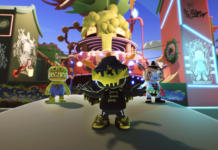Indiecade East features the full gamut of what it can mean to be “indie”. From a Sony booth featuring independent Vita and PS4 games, to a tournament for e-sport indie games like Nidhogg and Videoball, 2014’s Indiecade now showcases the high profile and the incredibly low profile. Located next to a Facebook booth and an Oculus Rift demo was a room dedicated to the little guys. Games were rotated every few hours, so I saw as much as I could. Here are my favorite up-and-comers:
Neon Kreiger Yamato

Combining the controls of technical 2D games like Strider or Megaman with the colorful and sprite-packed action of a Treasure game, Neon Kreiger Yamato has a lot of promise. The demo I played was early, with levels that felt more like bonus challenge modes than real environments. Still, the mechanics were solid, with lots of air juggling and satisfying d-pad double-taps to dash around quickly. This is a game that seems right at home on a handheld like the PS Vita or 3DS.
Joylancer

Taking less buttons and infusing them with more mechanics is a popular theme lately, but that doesn’t mean Joylancer is a tired concept. It may have more than a little in common with the upcoming Shovel Knight, but it manages to carve out its own path. The Game Boy inspired graphical treatment certainly helps. The game gives you a jump and lance attack that can be charged, and from there you can use your charged attacks to both fight and get around. The game keeps score, but doesn’t punish you for dying, allowing you to focus more on getting around successfully and playing better on your own terms. It still feels challenging, and getting around with badass lance lunges can be really satisfying.
Relativity

Relativity may be the next game that puzzle fans talk about alongside Portal, Antichamber, and Q.U.B.E.. The premise here is that you can walk up to any surface in the environment and make that the floor, reorienting gravity and allowing you to walk anywhere you want. From there, devious puzzles and open-ended exploration ensue. Developer Willy Chyr told me that the game is at least a year off, but it already looks like a solid puzzle experience. He hopes to infuse the cold, clinical environments with some more purpose. He told me that if the game does have a story, his goal is to make sure it’s an extension of the gameplay itself. I’ll be really excited to see how this game evolves.
Moon Rabbit

Moon Rabbit is an odd experiment that can be summed up in seconds. The game randomly generates a strange creature’s face and you must find the mouth to feed it. Click on the mouth, feed the creature, and a new one is generated. You’ll never see the same face twice. It’s an odd bit of experimental gameplay that I spent entirely too long playing. The game gets you thinking about how the human brain makes associations and assumptions about what it sees. The game is nothing but squiggly lines but in my mind I’m feeding ducks and hamsters.
Mushroom 11

In this post-apocalyptic landscape, you are an amorphous blob. You can mold yourself around surfaces, condense to a single dot, or stretch out over a large area. You can split into pieces that grow back within seconds. Mushroom 11 is a touch-based puzzle game in which you must guide this blob through a dark and mysterious world. The gameplay is unique and impressive — it captivated an audience while one person played, complete absorbed, for about 20 minutes straight. I’d be very surprised if this doesn’t become a beloved, indie darling when it releases.
Enjoy random thoughts about the latest games, the Sega Saturn, or the occasional movie review? Follow me @JoeDonuts!










